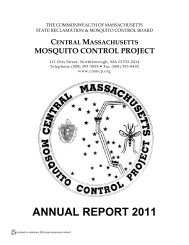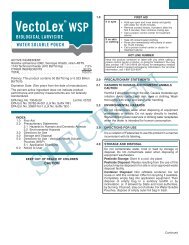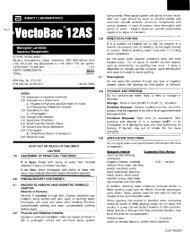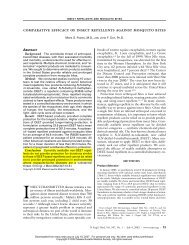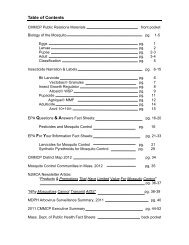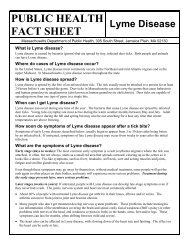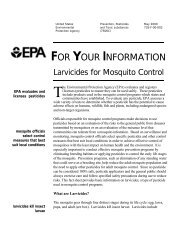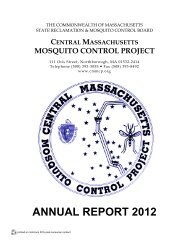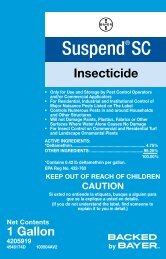marlboro - Central Mass. Mosquito Control
marlboro - Central Mass. Mosquito Control
marlboro - Central Mass. Mosquito Control
Create successful ePaper yourself
Turn your PDF publications into a flip-book with our unique Google optimized e-Paper software.
Once they have acquired their blood meal necessary for egg development, mosquitoes may use<br />
many different types of areas for breeding, including irrigated agricultural lands, shallow isolated<br />
pools, dumping areas, and wetlands (Knight, 2003). After obtaining a blood meal, the female<br />
mosquitoes will usually have a resting period before oviposition. It has been shown that<br />
mosquitoes don’t lay eggs randomly but instead may lay eggs where there are fewer predators<br />
present (Kiflawi, 2003).<br />
In many aspects of mosquito life history, temperature seems to play a very influential role. Low<br />
air temperatures in the winter lead many mosquito adults to enter a hibernation state and high<br />
temperatures in the summer can also lead to decreased adult mosquito activity (Knight, 2003).<br />
As noted before, temperature also plays an important role in the feeding habits of mosquitoes.<br />
Culex pipiens have been shown to prefer host temperatures between 32° C and 43°C, with<br />
temperatures above 49°C and below 30°C showing less attraction. Temperature also seems to<br />
have an effect on oviposition, with mosquitoes avoiding water temperatures outside the range of<br />
20°C to 30°C (Bates, 1949).<br />
There are several common trapping methods for adult mosquitoes. These include gravid traps<br />
that simulate oviposition habitat, light traps, and carbon dioxide traps with the latter two possibly<br />
being combined. With carbon dioxide being a major attractant for mosquitoes, yields from these<br />
traps are especially clean, containing almost no unwanted insects. The traps with light alone can<br />
produce many kinds of non-targeted insect species, which can slow research.<br />
Culex pipiens, as well as other mosquito species, has been discovered to prefer inhabiting tree<br />
canopies, or at least seem to frequent tree canopy height. The specific reasons for this behavior<br />
are not clear although it has been speculated that they may be influenced by temperature,<br />
humidity, light, as well as the potential feeding of nesting birds (Anderson, 2004). This project<br />
was geared toward gathering data on two of these possibilities, temperature and humidity. My<br />
hypothesis is that Culex pipiens and Culiseta melanura will both show a significant preference for<br />
the canopy level, but that this will not have a significant relationship with either temperature or<br />
humidity.<br />
METHODS<br />
Data collection for the project was started in late May 2005 and ended September 2, 2005. There<br />
were three different sites, two in Westborough, MA, and the other in neighboring Hopkinton. The<br />
two sites in Westborough were located off of Rogers St. (42°16.427’N, 071°36.033’W) and<br />
Hopkinton Rd. (42°15.709’N, 071°35.812’W), while the Hopkinton site was located off of Woods<br />
St. (42°15.354’N, 071°35.149’W).<br />
Trapping involved using two CDC light/CO 2 mosquito traps (John W. Hock Co., model 512) with<br />
net collection bags, one placed approximately 6.5 meters into the air and the other about 1.5<br />
meters high at the same site. Carbon dioxide was used as the only means of attractant, with the<br />
light feature of the traps being disabled to avoid non-target insects. The CO 2 tanks were adjusted<br />
with regulators to 15psi. On each trap there was a temperature/relative humidity data logger<br />
(Onset 64K HOBO Pro RH/Temp Logger) that logged each every 40 seconds while the trap was<br />
collecting.<br />
The traps were set and collected overnight and retrieved approximately 24 hours later and set<br />
again usually at one of the other sites, with new collection bags, new batteries and new CO 2<br />
tanks. The data logger information was downloaded and reset at each retrieval. The specimen<br />
collections were knocked down and stored in a refrigerator until identification. The specimens<br />
were identified as Culex pipiens, Culiseta melanura, or “other,” by using the Darsie mosquito<br />
index (1981) and a dissecting microscope.<br />
The data collected from the data loggers and mosquito identification was then used in several<br />
ANOVAs to determine whether there were significantly different findings for the two trap levels,





